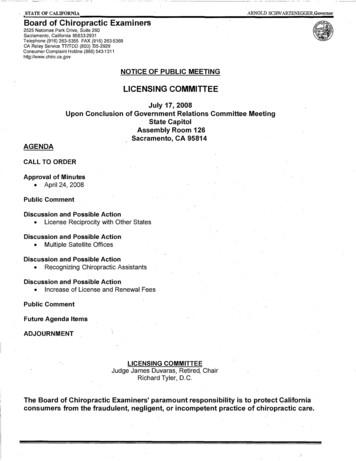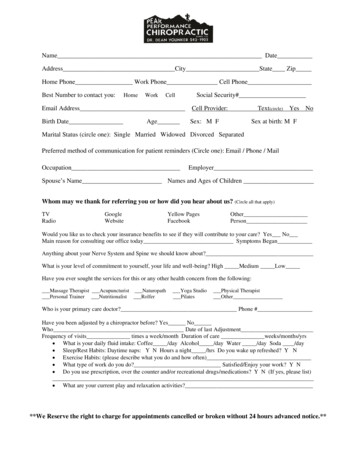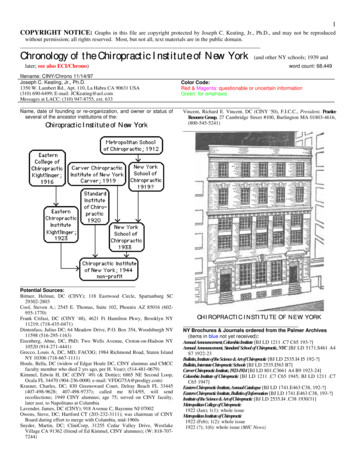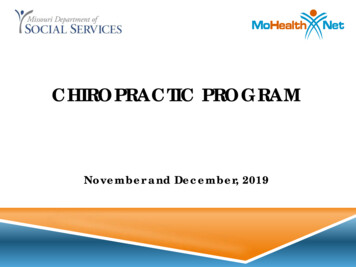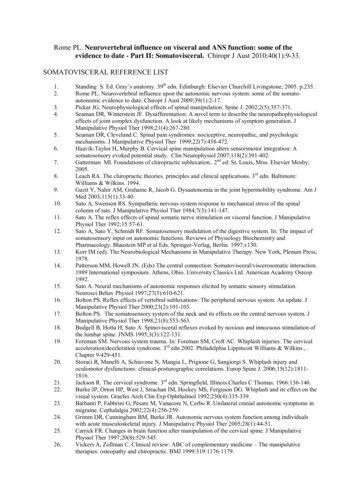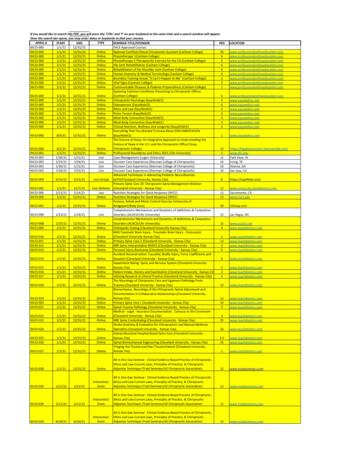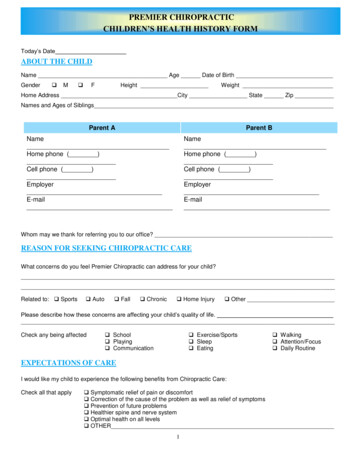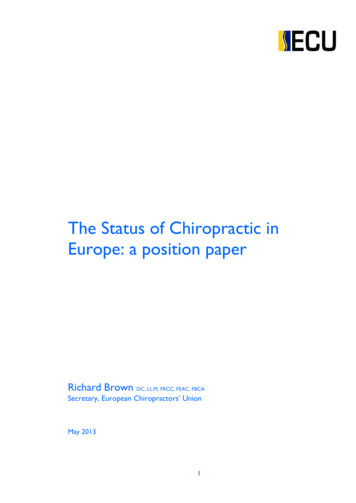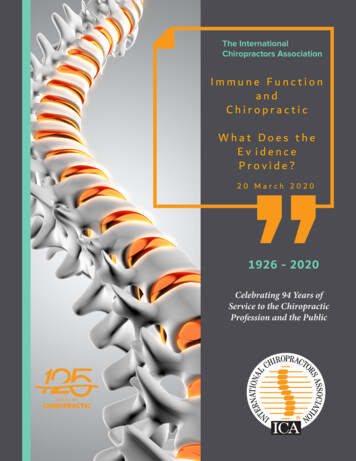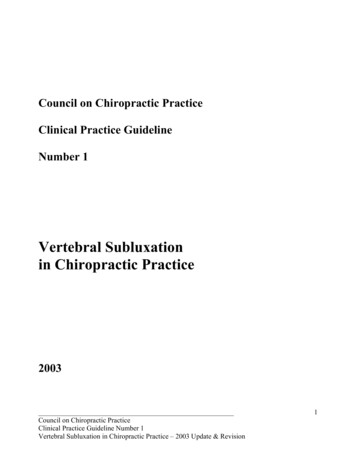
Transcription
Council on Chiropractic PracticeClinical Practice GuidelineNumber 1Vertebral Subluxationin Chiropractic Practice2003Council on Chiropractic PracticeClinical Practice Guideline Number 1Vertebral Subluxation in Chiropractic Practice – 2003 Update & Revision1
Clinical Practice Guideline:Vertebral Subluxationin Chiropractic PracticePublished by:Council on Chiropractic PracticeCopyright 2003 by Council on Chiropractic PracticeAll rights reserved. This publication may not be reproduced, stored in aretrieval system, or transmitted in whole or in part, in any form or byany means, electronic, mechanical, photocopying, recording, orotherwise, without prior written permission of the publisher.Library of Congress Control Number: 2003111260ISBN: 0-9666598-9-9Council on Chiropractic PracticeClinical Practice Guideline Number 1Vertebral Subluxation in Chiropractic Practice – 2003 Update & Revision2
CCP Board of DirectorsChristopher Kent, D.C., F.C.C.I.President, Council on Chiropractic PracticePost-grad Faculty Life UniversityRamsey, New JerseyVeronica Gutierrez, D.C.White House Commission on Complementaryand Alternative MedicinePrivate Practitioner - Arlington, WashingtonMatthew McCoy, D.C., D.A.C.S. (Cand.)Vice President & Guidelines CommitteeChair, Council on Chiropractic PracticeDirector of Research - Life UniversityMarietta, GeorgiaJerry Hardee, D.C.President, Sherman College of StraightChiropracticTerry Rondberg, D.C.Treasurer, Council on Chiropractic PracticePresident, World Chiropractic AllianceChandler, ArizonaJay M. Holder, D.C., C.Ad., DACACDPresident, American College ofAddictionology & Compulsive DisordersPrivate PractitionerDeveloper - Torque Release TechniqueMiami Beach, FloridaBarbara Bigham, B.A.Secretary, Council on Chiropractic PracticeDirector of CommunicationsWorld Chiropractic AllianceDavid Koch, D.C.Vice President for International AffairsPalmer College of ChiropracticDavenport, IowaRobert Blanks, Ph.DProfessor, Dept of Biomedical SciencesFlorida Atlantic UniversityChair, Research CommitteeCouncil on Chiropractic PracticeMichael McGee, M.EdCCP Consumer MemberStudent Life DepartmentLock Haven UniversityMadeline Behrendt, D.C.Associate Editor, Journal of VertebralSubluxation ResearchChair, World Chiropractic AllianceCouncil on Women's HealthEdward F. Owens, Jr. M.S., D.C.Director of Research, Sherman College ofStraight ChiropracticEditorial Board – Journal of VertebralSubluxation ResearchW. Ralph Boone, D.C., Ph.DPast President - New Zealand College ofChiropractic. Editor Emeritus – Journal ofVertebral Subluxation ResearchSteve Renner, D.C., D.A.C.S.Member A. Board of Forensic ExaminersPrivate Practitioner Washington StatePatrick Gentempo Jr., D.C.CEO - Chiropractic Leadership AlliancePaterson, New JerseyWilliam Sloane, J.D., LL.M, Ph.D,Academic Dean, Capital University ofIntegrative MedicineFellow, American College of WellnessCouncil on Chiropractic PracticeClinical Practice Guideline Number 1Vertebral Subluxation in Chiropractic Practice – 2003 Update & Revision3
DisclaimerThe purpose of these guidelines is to provide the doctor of chiropractic with a “userfriendly” compendium of recommendations based upon the best available evidence. It isdesigned to facilitate, not replace, clinical judgment.As Sackett wrote, “External clinical evidence can inform, but can never replace,individual clinical expertise, and it is this expertise that decides whether the externalevidence applies to the individual patient at all and, if so, how it should be integrated intoa clinical decision. Similarly, any external guideline must be integrated with individualclinical expertise in deciding whether and how it matches the patient’s clinical state,predicament, and preferences, and thereby whether it should be applied. 1The most compelling reason for creating, disseminating, and utilizing clinical practiceguidelines is to improve the quality of health care. The recommendations made in thisguideline are specific to the clinical entity of vertebral subluxation and are applicable tothe stated goals of the guideline. Consistent with Sackett’s statement, therecommendations are meant to be flexible based upon each patient encounter and thegoals of both the practitioner and the patient being cared for.These guidelines are for informational purposes. Utilization of these guidelines isvoluntary. They are not intended to replace the clinical judgment of the chiropractor. It isacknowledged that alternative practices are possible and may be preferable under certainclinical conditions. The appropriateness of a given procedure must be determined by thejudgment of the practitioner and the needs and preferences of the individual patient.It is not the purpose or intent of these guidelines to provide legal advice, or to supplantany statutes, rules, and regulations of a government body having jurisdiction over thepractice of chiropractic.These guidelines address vertebral subluxation in chiropractic practice, and do notpurport to include all procedures which are permitted by law in the practice ofchiropractic. Lack of inclusion of a procedure in these guidelines does not necessarilymean that the procedure is inappropriate for use in the practice of chiropractic.Participation in the guidelines development process does not necessarily imply agreementwith the final product. This includes persons who participated in the techniqueconference, leadership conference, open forum, and peer review process. Listing ofnames acknowledges participation only, not necessarily approval or endorsement. TheCouncil on Chiropractic PracticeClinical Practice Guideline Number 1Vertebral Subluxation in Chiropractic Practice – 2003 Update & Revision4
guidelines reflect the consensus of the panel, which gave final approval to therecommendations.1.Sackett DL. Editorial: Evidence-based medicine. Spine 1998; 23(10):1085.Council on Chiropractic PracticeClinical Practice Guideline Number 1Vertebral Subluxation in Chiropractic Practice – 2003 Update & Revision5
Council on Chiropractic Practice Clinical Guideline Number 1. VertebralSubluxation in Chiropractic Practice. 2003 Update and Revision.This document contains the changes, additions and revisions to the 1998 Council onChiropractic Practice Clinical Guideline Number 1. Vertebral Subluxation in ChiropracticPractice and is organized in the following manner: Introduction to the development of Clinical Guideline Number 1 and the updatingand revision process.Description of the development methodology for both the 1998 and 2003documents.A description of the changes, additions and revisions to the Recommendations,Sub-recommendations and Commentary as a result of the 2003 review.If changes to a Recommendation have been made this is listed and discussed.If changes in Commentary following any recommendation have been made this islisted and discussed.If changes to a Conclusion have been made this is listed and discussed.If additional literature on the topic was found and reviewed then these referencesare listed at the end of the chapter.If a Recommendation, Commentary or Conclusion was added that was notincluded in the 1998 Guidelines, this is noted.If a Recommendation, Commentary or the literature remains as it did in the 1998guidelines a simple statement that the Recommendation, Commentary orliterature remains unchanged follows that section/topic.Council on Chiropractic PracticeClinical Practice Guideline Number 1Vertebral Subluxation in Chiropractic Practice – 2003 Update & Revision6
ContentsIntroduction and Methodology .91.History and Chiropractic Examination .43Case HistoryChiropractic ExaminationElements of the ExaminationChiropractic AnalysisClinical ImpressionInitial ConsultationReferences 442.Instrumentation 46Postural AnalysisBilateral and Four-Quadrant Weight ScalesMoire nt Perception Threshold (CPT) TestingElectroencephalography (EEG)Somatosensory Evoked Potentials (SSEP)Skin Temperature InstrumentationSurface ElectromyographyMuscle Strength TestingQuestionnairesHeart Rate VariabilityReferences .513.Radiographic and Other Imaging 69VideofluoroscopyMagnetic Resonance Imaging (MRI)Computed Tomography (CT)Spinal UltrasonographyRadioisotope Scanning (Nuclear Medicine Studies)Radiographic DigitizingReferences .72Council on Chiropractic PracticeClinical Practice Guideline Number 1Vertebral Subluxation in Chiropractic Practice – 2003 Update & Revision7
4.Clinical Impression and Assessment 84Record KeepingPeer ReviewChiropractic NecessityReferences . 915.Reassessment and Outcomes Assessment 98References .996.Modes of Adjustive Care . 100References .1017.Duration of Care for Correction of Vertebral Subluxation 134References .1398.Chiropractic Care of Children 141References .1429.Maternal Care .147References .15210.Patient Safety . .154References 15511.Professional Development 158References 16112.Patient Privacy 162References .164Table 1. Methodological Standards for Practice Guidelines .165Table 2. Characteristics of Peer Reviewers . 166Contributors, Panel Members & Peer Reviewers 167Council on Chiropractic PracticeClinical Practice Guideline Number 1Vertebral Subluxation in Chiropractic Practice – 2003 Update & Revision8
IntroductionThe Council on Chiropractic PracticeIn the summer of 1995, chiropractic history was made in Phoenix, Arizona with theformation of the Council on Chiropractic Practice (CCP). This initial meeting wasattended by an interdisciplinary assembly of distinguished chiropractors, medicalphysicians, basic scientists, attorneys, and consumer representatives. 1-2The CCP was founded as an apolitical, non-profit organization. It is not affiliated withany other chiropractic association. The development of the CCP represents a grass-rootsmovement to produce practice guidelines which serve the needs of the consumer, and areconsistent with “real world” chiropractic practice.The mission of the CCP is “To develop evidence-based guidelines, conduct research andperform other functions that will enhance the practice of chiropractic for the benefit ofthe consumer.”The Council on Chiropractic Practice developed and published its first set of clinicalguidelines in 1998 titled Clinical Guideline Number 1 Vertebral Subluxation inChiropractic Practice.3 An abbreviated version of the document was also published inthe Journal of Vertebral Subluxation Research in November 1998.4The CCP Guides were intended to be used by practicing chiropractors, health careeducators, chiropractic organizations, patients, insurance companies, attorneys,governmental officials and any other individual or group needing information about thepractice of subluxation-centered chiropractic.This guideline went on to become widely distributed and accepted within and outside thechiropractic profession. Following publication the Council on Chiropractic Practicemailed 50,000 copies of the document to licensed chiropractors in the United States and asimilar effort occurred in Canada with the document being distributed throughout severalprovinces.5,6Some state licensing boards and state associations either adopted the guidelines as anacceptable standard of care and/or officially endorsed the document includingWashington and Indiana.7-9On Mar. 17, 1999 Congressman Frank Pallone, Jr., of New Jersey who serves on theHealth and Environment Subcommittee of the House Commerce Committee, addressedthe Speaker of the House of the U.S. House of Representatives and publicly commended9Council on Chiropractic PracticeClinical Practice Guideline Number 1Vertebral Subluxation in Chiropractic Practice – 2003 Update & Revision
the Council on Chiropractic Practice for its efforts in developing and distributing theguidelines.10In May 1999 the CCP Guidelines were ratified by the Manitoba ChiropractorsAssociation and in 2000 the CCP Guidelines were officially recognized by the College ofChiropractors of Alberta and the Chiropractic Awareness Council of Ontario also adoptedthe Guidelines.6,11,12Other licensing boards and professional associations in other countries have adopted orendorsed the guidelines including the Israeli Doctors of Chiropractic (IDOC) and theChiropractors Association of Ireland.13,14In addition to the broad acceptance of the document, the guidelines themselves were alsoreviewed and subsequently incorporated into a separate guidelines document publishedby the International Chiropractors Association titled: Recommended Clinical Protocolsand Guidelines for the Practice of Chiropractic.15The Council on Chiropractic Practice has been working with the World HealthOrganization as that entity develops international guidelines for the practice ofchiropractic. As part of that effort the CCP worked with the World Chiropractic Allianceand the World Health Organization to develop a document titled: Guidelines on Trainingand Safety in Chiropractic.16Inclusion in the National Guideline ClearinghouseFollowing publication of the CCP Guidelines the document was submitted to the NationalGuideline Clearinghouse for consideration for inclusion. The NGC is sponsored by theU.S. Agency for Health Care Research & Quality and is in partnership with the AmericanMedical Association and the American Association of Health Plans. Its mission is asfollows:The NGC mission is to provide physicians, nurses, and otherhealth professionals, health care providers, health plans,integrated delivery systems, purchasers and others an accessiblemechanism for obtaining objective, detailed information onclinical practice guidelines and to further their dissemination,implementation and use.17The AHRQ contracts with ECRI, a nonprofit health services research agency, to performthe technical work for the NGC. ECRI is an international nonprofit health servicesresearch agency and a Collaborating Center of the World Health Organization.Council on Chiropractic PracticeClinical Practice Guideline Number 1Vertebral Subluxation in Chiropractic Practice – 2003 Update & Revision10
In November of 1998, following review by ECRI, the CCP Guidelines were accepted forinclusion within the National Guideline Clearinghouse.Overview of the Development of the 1998 GuidelinesIn harmony with the general principles of guideline development at the time, the CCPoriginally created a multidisciplinary panel, supported by staff, and led by a projectdirector. The guidelines were produced with input from methodologists familiar withguidelines development.The first meeting of the Council on Chiropractic Practice took place on June 8, 1995 inChandler, Arizona and the Council was subsequently incorporated as a non-profitorganization. The first endeavor of the panel was to analyze available scientific evidencerevolving around a model, which depicts the safest and most efficacious delivery ofchiropractic care to the consumer. A contingent of panelists, chosen for their respectiveskills, directed the critical review of numerous studies and other evidence.The process began with a detailed literature search which was broad in nature utilizingboth electronic search vehicles including Medline and MANTIS, the Cumulative Index toNursing and Allied Health Literature (CINAHL) as well as stack searches to ensure thatall applicable literature relevant to vertebral subluxation in chiropractic clinical practicewas gathered. To further ensure that all relevant literature and evidence was gathered andreviewed the panel held a second meeting to interview technique developers to ascertainthe degree to which their procedures can be expressed in an evidence-based format.Individuals representing over thirty-five named techniques participated.Others made written submissions to the panel. The technique developers presented thebest available evidence they had to substantiate their protocols and assessment methods.A primary goal of the panel was to stimulate and encourage field practitioners to adapttheir practices to improve patient outcomes. To achieve this objective, it was necessaryto involve as many practitioners as possible in the development of workable guidelines. Itwas also important to the panel to secure input from field practitioners who would be oneclass of the end users of any guidelines produced.Consistent with the recommendations of AHCPR (now AHRQ), an “Open Forum” washeld where any interested individual could participate. Practitioners offered theiropinions and insights in regard to the progress of the panel. Field practitioners who wereunable to attend the Open Forum session were encouraged to make written submissions.Consumer and attorney participants offered their input. A meeting was also held withchiropractic consultants and organizational leadership to secure their participation andgather feedback.Council on Chiropractic PracticeClinical Practice Guideline Number 1Vertebral Subluxation in Chiropractic Practice – 2003 Update & Revision11
The literature and other information gathered during this process was then reviewed by apanel of experts who submitted critical review using an “Abstraction Form.” The reviewsincluded questions on: InterventionsOutcomesHarmsInstrumentation & AnalysisSpinal AnalysisStudy FindingsStudy Design FlawsAfter sorting and evaluating the evidence gathered in the literature search, techniqueforum, leadership forum, written comments, open forum and the review process, thepanel rated and categorized the evidence. After sorting, evaluating, rating andcategorizing the evidence (rating and categorizing criteria is discussed later in thisdocument) an initial draft of the guidelines was prepared and distributed to the panel forreview and criticism. A revised draft was prepared based upon this input.International input from the field was obtained when the working draft guidelinesdocument was submitted to 195 peer reviewers in 12 countries. After incorporation of thesuggestions from these reviewers, a final draft was presented to the panel for approval.This document was then submitted for proofreading and typesetting and wassubsequently published.Guidelines Development Process & MethodologySince the original 1998 version of the CCP Guidelines, much has been written on thesubject of guidelines methodology and more information for guideline development hasbeen made available. The Guidelines Panel made a concerted effort to review theliterature on guidelines development and methodology prior to beginning the actualrevision of the 1998 CCP Guides.A detailed search of the guideline development methodology and implementationliterature published since 1995 was undertaken by members of the guidelines committeeand pertinent concepts and procedures incorporated into the process.18-59 Particularly, thepanel sought to more explicitly describe its methodology. While the methodologyfollowed for the 1998 process was clearly described in various trade journals as well asamongst the participants, the CCP Guides were criticized for not describing its methodsof development more clearly.Council on Chiropractic PracticeClinical Practice Guideline Number 1Vertebral Subluxation in Chiropractic Practice – 2003 Update & Revision12
Unfortunately, these criticisms were at times based on guidelines development literaturepublished only after the CCP guides were created and distributed. This new literature wasreviewed carefully and the recommendations incorporated into the current process ofrevision and updating.In particular the panel found the article by Shaneyfelt et al particularly helpful.18 Many ofthe key elements outlined in the article were utilized in the development of the guidelinesand are used as topic headings throughout this document. Table 1 summarizes these keyelements.Purpose of the CCP GuidelinesThe CCP has developed practice guidelines for vertebral subluxation and one of thepurposes of these guidelines is to provide the doctor of chiropractic with a “user friendly”compendium of recommendations based upon the best available evidence. The purposeis to facilitate, not replace, clinical judgment and ultimately to improve the quality ofhealth care.These guidelines are for informational purposes, utilization of these guidelines isvoluntary and they are not intended to replace the clinical judgment of the chiropractor. Itis acknowledged that alternative practices are possible and may be preferable undercertain clinical conditions. The appropriateness of a given procedure must be determinedby the judgment of the practitioner and the needs and preferences of the individualpatient.It is not the purpose or intent of these guidelines to provide legal advice, or to supplantany statutes, rules, and regulations of a government body having jurisdiction over thepractice of chiropractic.These guidelines address vertebral subluxation in chiropractic practice, and do notpurport to include all procedures which are permitted by law in the practice ofchiropractic. They do not purport to include the management of conditions or clinicalfindings other than vertebral subluxation and its components. Lack of inclusion of aprocedure in these guidelines does not necessarily mean that the procedure isinappropriate for use in the practice of chiropractic. The reader is encouraged to consultother guidelines that address the application of chiropractic in other clinical situations.Participation in the guidelines development process does not necessarily imply agreementwith the final product. This includes persons who participated in the techniqueconferences, leadership conference, open forum, and peer review process. Listing ofnames acknowledges participation only, not necessarily approval or endorsement.Council on Chiropractic PracticeClinical Practice Guideline Number 1Vertebral Subluxation in Chiropractic Practice – 2003 Update & Revision13
The guidelines reflect the consensus of the panel, which gave final approval to therecommendations.Rationale and Importance of the GuidelineThese guidelines for vertebral subluxation were developed because the Council and itsconstituents recognized the need for guidelines that deal specifically with the vertebralsubluxation and its management. Other guidelines have been developed that address amyriad of conditions and symptoms reported to be amenable to chiropractic interventionand/or spinal manipulation.60-62 These other guidelines blur the boundaries regarding carefor the amelioration of various pain syndromes and at the same time blur the boundariesregarding the interventions used to affect a response. In addition, none of these guidelineshave been updated since its original dissemination and one of them, the MercyGuidelines, is approaching a decade since publication.One of the rationales for the development of a guideline specifically addressing theclinical entity of vertebral subluxation is to bring clarity to the issue of what entities,conditions, disorders, or symptoms chiropractors deal with and the procedures they use.Clarity is considered an attribute of good practice guidelines by the Institute ofMedicine.63 An example of the clarity portrayed in the CCP Guides would be thedistinction between the terms adjustment and manipulation. While a manipulation may beused by a host of health care providers to affect joint function, only the chiropractor usesthe adjustment to reduce or correct vertebral subluxation. The CCP guides do not addressthe use of a chiropractic adjustment for any other clinical situation.The importance of this distinction cannot be overemphasized since the profession ofchiropractic entails many types of providers and the profession enjoys a broad scope inmost if not all jurisdictions. Because of this latitude in scope of practice there arediffering styles of practice based on the extent of the implementation of procedures andmanagement by individual chiropractors. Some practitioners choose to practice at theextreme limits of their practice scope. This means that chiropractors in Oregon, forexample, may choose to diagnose and treat gynecological problems because their scopeallows for it and they desire to do so, or they may elect to strictly limit their practice tothe detection and correction of vertebral subluxation.It is the opinion of the Council that it would be prudent for those interested in theapplications of gynecological diagnosis and management for example, to consultguidelines that address these issues as opposed to expecting that chiropractic guidelinesaddress all conditions and disorders that a particular scope allows.Council on Chiropractic PracticeClinical Practice Guideline Number 1Vertebral Subluxation in Chiropractic Practice – 2003 Update & Revision14
There have historically been groups of chiropractors in the profession that choose topractice in various ill defined categories where scope is the limiting or expanding factor.These various groups are becoming more clearly defined and as a result of this, morespecific guidelines such as these that seek to address vertebral subluxation only, areextremely important.64 The importance is manifested when chiropractors or organizationsdialogue with payor groups, the government, legal issues/groups and especially theconsumers of chiropractic services. Recent accreditation and legal issues confronting thechiropractic profession only serve to heighten the importance of these distinctions and theimportance of guidelines that address them.65,66The importance of a guideline that addresses vertebral subluxation is also illustrated bythe widespread adoption of the Association of Chiropractic Colleges ParadigmStatement.67 This Statement was discussed briefly in the 1998 CCP Guidelinespublication, however since that time this Statement, developed and signed by thePresidents of all of the North American Chiropractic Colleges, has enjoyedunprecedented endorsement throughout the chiropractic profession.68 It has received suchwidespread support that some have remarked that never in the history of the professionhas there been this extent of agreement on anything. This statement has been endorsedand/or adopted by every major national and international chiropractic organization in theprofession including:The World Chiropractic AllianceThe Council on Chiropractic PracticeThe Council on Chiropractic EducationThe International Chiropractor's AssociationThe American Chiropractor's AssociationThe World Federation of ChiropracticThe Congress of Chiropractic State AssociationsThe Association of Chiropractic CollegesThe Foundation for Chiropractic Education & ResearchThe Federation of Chiropractic Licensing BoardsNational Board of Chiropractic ExaminersThe National Association of Chiropractic AttorneysThe Paradigm Statement defines the responsibility of chiropractors to include thedetection and correction of vertebral subluxation and its resultant neurologicalinterference. The existence of subluxation is in accordance with this paradigm statementand the ACC defines the purpose, principles and practice of chiropractic as the findingand reduction of vertebral subluxations, which will prevent and restore health byremoving interference to the body's inherent recuperative powers.Council on Chiropractic PracticeClinical Practice Guideline Number 1Vertebral Subluxation in Chiropractic Practice – 2003 Update & Revision15
This document, among other things, states that chiropractic as a profession "focusesparticular attention on the subluxation."Further to this, the majority of state laws and the United States Federal Government alldefine the responsibility of chiropractors to include the detection and correction ofvertebral subluxation and its resultant neurological interference.The assessment and management of vertebral subluxation is either taught as part of theregular curriculum of all chiropractic colleges in North America or as part of their postgraduate programs. All of these programs, including the general curriculum of thechiropractic colleges and the post graduate programs, are approved and accredited by theCouncil on Chiropractic Education which is subject to the rules and authority of theUnited States Federal Government's Department of Education. These schools also holdaccreditation through various local and regional accrediting bodies.The Council on Chiropractic Education, mentioned above, accredits all of thechiropractic programs in the United States and has reciprocal arrangements withaccrediting bodies in Europe and other regions. According to the Policies document ofthe CCE: 69The Council on Chiropractic Education (CCE) acceptsthe physiological principles of organization in livingthings and the manifestation of the self-regulatorymechanisms inherent in the body.CCE accepts that the nervous system is vulnerable todisturbances resulting from derangements of theneurobiomechanical system, including the vertebralcolumn and vertebral subluxations.The educational process should be a reinforcement ofthe validity of the basic principles of chiropractic andan encouragement to the student to apply thoseprinciples in his or her clinical programs, withemphasis given to detection and correction ofderangements of the neurobiomechanical system,including vertebral subluxation.”Council on Chiropractic PracticeClinical Practice Guideline Number 1Vertebral Subluxation in Chiropractic Practice – 2003 Update & Revision16
The American Medical Association, in its Guides to the Evaluation of PermanentImpairment, lists the following as acc
The Council on Chiropractic Practice developed and published its first set of clinical guidelines in 1998 titled Clinical Guideline Number 1 Vertebral Subluxation in Chiropractic Practice.3 An abbreviated version of the document was also published in the Journal of Vertebral Subluxation Research in November 1998.4
